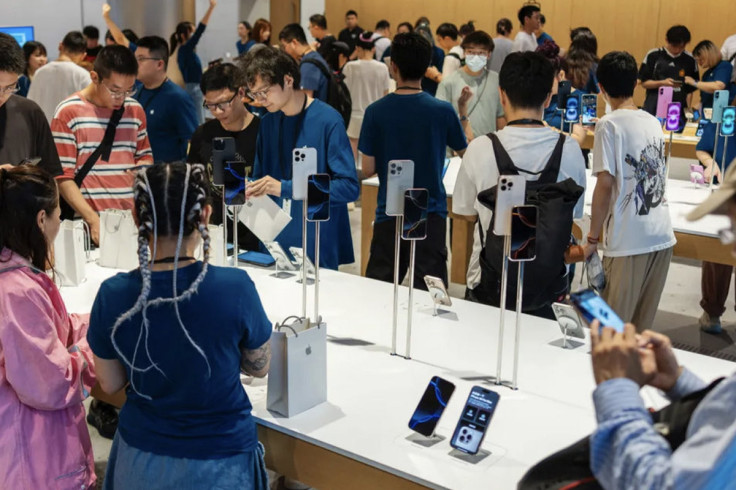Panic Buying Hits Apple Stores As Trump's Tariff War Threatens To Hike iPhone Prices
Apple stores have reportedly seen a significant uptick in sales

A wave of last-minute shoppers has flooded Apple stores across the United States as fears mount that President Donald Trump's sweeping new tariffs could dramatically inflate iPhone prices. With a 54% levy on Chinese goods looming, consumers are racing to beat the hike—prompting analysts to warn that the cost of Apple's most popular product could soar by hundreds of pounds.
According to Bloomberg, multiple Apple retail locations reported unusually busy weekends as worried customers rushed in to purchase iPhones ahead of anticipated price increases. Store employees likened the atmosphere to Christmas shopping season, saying many buyers were driven by speculation that new tariffs would push prices to unprecedented levels.
The Pre-Tariff Frenzy
Apple's iPhones, which are predominantly manufactured in China, now face a 54% import duty under Trump's aggressive trade policy. 'Almost every customer asked me if prices were going to go up soon,' said one Apple employee, who asked not to be named. While the queues didn't match those seen during a product launch, the mood was described as frantic and uncertain.
Bloomberg reported that Apple stores across key markets recorded higher sales over the weekend than during the same period in previous years. No formal guidance was issued by Apple on how staff should address customer concerns, but the consumer reaction was swift and widespread.
How Much More Will iPhones Cost?
iPhones could soon cost up to $2,300 in the U.S. due to tariffs 😳
— Apple Hub (@theapplehub) April 4, 2025
iPhone prices could rise by 43%, meaning the base iPhone 16 model could start at $1,142 and the most expensive iPhone 16 Pro Max model could cost up to $2,300
Source: @Reuters pic.twitter.com/Eu4oeqYEpp
Industry experts have painted a bleak picture of potential price hikes. If Apple were to pass on the full cost of the tariffs to consumers, the price of iPhones could rise by 30% to 43%, depending on the model.
The base iPhone 16 currently starts at £624.84 ($799). However, Reuters notes that a 43% increase could lift the entry-level model to around £893.07 ($1,142). For those eyeing the high-end iPhone 16 Pro Max, which sells for £1,250.46 ($1,599), a similar price hike would push the cost to a staggering £1,798.66 ($2,300).
Apple's more affordable model, the iPhone 16e, introduced in February as a lower-cost entry into the brand's AI-powered features, is currently priced at £468.43 ($599). Should tariffs force Apple's hand, it could jump to £669.41 ($856), per forecasts from Rosenblatt Securities.
Analysts Sound the Alarm
US tariff is going to help Apple a lot. These countries currently charging from 9% to 35% tariffs on iPhones, and that about to change forever pic.twitter.com/1WbUVzkwwr
— Reader (@ReaderX07) April 6, 2025
'This whole China tariff thing is playing out right now completely contrary to our expectation that American icon Apple would be kid-gloved, like last time,' said Barton Crockett of Rosenblatt Securities.
While Apple has spent recent years diversifying its supply chain—expanding production into Vietnam and India—most of its devices are still assembled in China. And although Vietnam and India also face tariffs, they are notably lower at 46% and 26% respectively.
Still, Apple could struggle to absorb the added costs without alienating price-sensitive consumers. 'We expect Apple to hold off on any major increases on phones until this autumn when its iPhone 17 is set to launch, as it is typically how it handles planned price hikes,' said Angelo Zino of CFRA Research.
Will Apple Customers Foot the Bill?
Zino estimates that Apple may only be able to pass along 5% to 10% of the tariff cost directly to consumers. But other analysts are less optimistic. Neil Shah of Counterpoint Research argues Apple would need to raise prices by at least 30% on average to remain profitable.
The concern is that such steep increases could hand rival brands like Samsung a competitive edge. South Korean manufacturers face significantly lower tariffs, and any move that makes iPhones less affordable could cause consumers to jump ship.
In the short term, Apple's shortfall may be cushioned by this surge in panic buying. But the longer-term implications of Trump's tariff blitz remain uncertain. As noted by the International Business Times, the tariffs are already wreaking havoc across global markets. Whether Apple can weather the storm without alienating its loyal customer base is yet to be seen.
Originally published on IBTimes UK





















